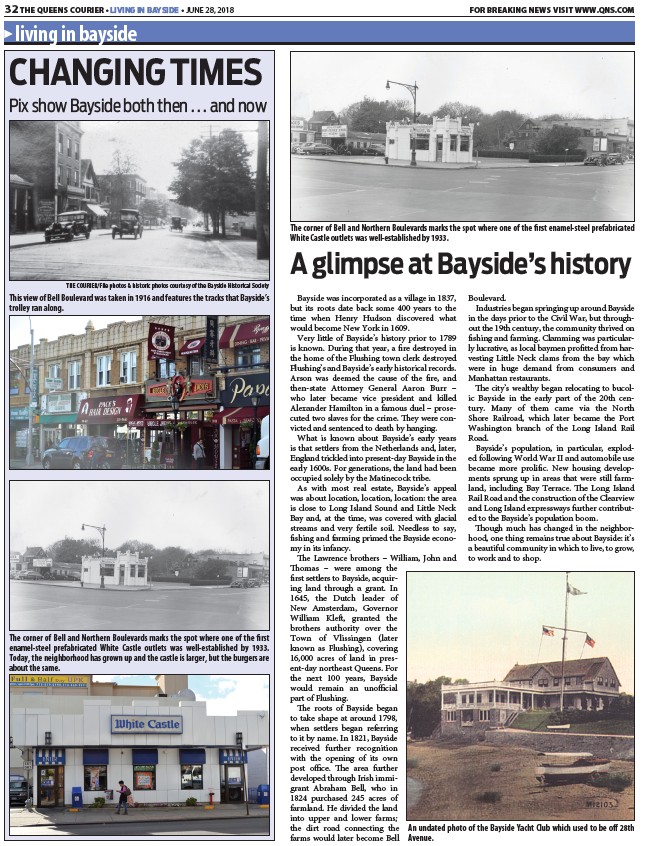
32 THE QUEENS COURIER • LIVING IN BAYSIDE • JUNE 28, 2018 FOR BREAKING NEWS VISIT WWW.QNS.COM
living in bayside
The corner of Bell and Northern Boulevards marks the spot where one of the first enamel-steel prefabricated
White Castle outlets was well-established by 1933.
A glimpse at Bayside’s history
Bayside was incorporated as a village in 1837,
but its roots date back some 400 years to the
time when Henry Hudson discovered what
would become New York in 1609.
Very little of Bayside’s history prior to 1789
is known. During that year, a fire destroyed in
the home of the Flushing town clerk destroyed
Flushing’s and Bayside’s early historical records.
Arson was deemed the cause of the fire, and
then-state Attorney General Aaron Burr –
who later became vice president and killed
Alexander Hamilton in a famous duel – prosecuted
two slaves for the crime. They were convicted
and sentenced to death by hanging.
What is known about Bayside’s early years
is that settlers from the Netherlands and, later,
England trickled into present-day Bayside in the
early 1600s. For generations, the land had been
occupied solely by the Matinecock tribe.
As with most real estate, Bayside’s appeal
was about location, location, location: the area
is close to Long Island Sound and Little Neck
Bay and, at the time, was covered with glacial
streams and very fertile soil. Needless to say,
fishing and farming primed the Bayside economy
in its infancy.
The Lawrence brothers – William, John and
Thomas – were among the
first settlers to Bayside, acquiring
land through a grant. In
1645, the Dutch leader of
New Amsterdam, Governor
William Kleft, granted the
brothers authority over the
Town of Vlissingen (later
known as Flushing), covering
16,000 acres of land in present
day northeast Queens. For
the next 100 years, Bayside
would remain an unofficial
part of Flushing.
The roots of Bayside began
to take shape at around 1798,
when settlers began referring
to it by name. In 1821, Bayside
received further recognition
with the opening of its own
post office. The area further
developed through Irish immigrant
Abraham Bell, who in
1824 purchased 245 acres of
farmland. He divided the land
into upper and lower farms;
the dirt road connecting the
farms would later become Bell
Boulevard.
Industries began springing up around Bayside
in the days prior to the Civil War, but throughout
the 19th century, the community thrived on
fishing and farming. Clamming was particularly
lucrative, as local baymen profitted from harvesting
Little Neck clams from the bay which
were in huge demand from consumers and
Manhattan restaurants.
The city’s wealthy began relocating to bucolic
Bayside in the early part of the 20th century.
Many of them came via the North
Shore Railroad, which later became the Port
Washington branch of the Long Island Rail
Road.
Bayside’s population, in particular, exploded
following World War II and automobile use
became more prolific. New housing developments
sprung up in areas that were still farmland,
including Bay Terrace. The Long Island
Rail Road and the construction of the Clearview
and Long Island expressways further contributed
to the Bayside’s population boom.
Though much has changed in the neighborhood,
one thing remains true about Bayside: it’s
a beautiful community in which to live, to grow,
to work and to shop.
An undated photo of the Bayside Yacht Club which used to be off 28th
Avenue.
CHANGING TIMES
Pix show Bayside both then . . . and now
THE COURIER/File photos & historic photos courtesy of the Bayside Historical Society
This view of Bell Boulevard was taken in 1916 and features the tracks that Bayside’s
trolley ran along.
The corner of Bell and Northern Boulevards marks the spot where one of the first
enamel-steel prefabricated White Castle outlets was well-established by 1933.
Today, the neighborhood has grown up and the castle is larger, but the burgers are
about the same.